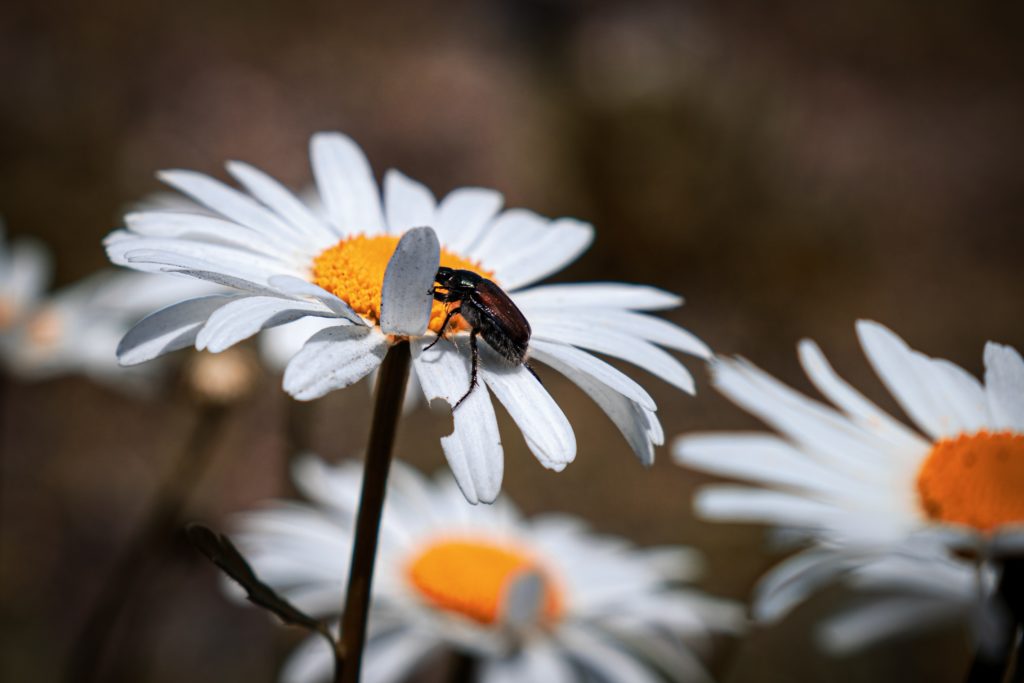Invasion of the Iridescent Green Terror!

Are Japanese Beetles terrorizing your plants? Mine too. It’s like a horror movie with metallic green beetles sucking the life out of my garden. They are quite a nuisance starting in early to mid-July and continuing for 6-8 weeks each year. Infestations vary in severity year to year, but even in a light year they can do quite a bit of damage. The good news is that they rarely kill healthy plants, although the damage may make weakened birch and linden trees may be more susceptible to borers, which can kill them.
These nasty little pests were first seen in the US in 1916 in New Jersey. They can now be found in every state in the eastern half of the country, except Florida, and are considered invasive. The grubs eat the roots of turf grass, and the adults will eat over 300 different plants, skeletonizing leaves, ruining fruit, and causing flowers to wilt and drop. Here are a few tips on how to manage them and minimize the damage to your yard and garden.
As I mentioned before, the grubs feed on turf grass. If they are eating your lawn, you may find patches of dead grass that lift easily from the soil. When you lift it, you’ll see the grubs. They are small, white, and are generally curled in the shape of a C. Not watering your lawn in July and August when grubs are most active can help control them. When present in numbers they can do so much damage that areas of lawn can literally be rolled up like carpet due to the lack of roots. If the situation is severe enough, you may want to treat your lawn with beneficial nematodes or pesticides. Pesticides may be harmful to both insects and animals, and beneficial nematodes, while considered a safer option, may possibly still be harmful for bees. In the end, treating your lawn will not reduce the number of adult beetles on your plants since they will fly quite far in search of food, so unless the grubs themselves are problematic, it is not recommended.
Managing adult beetles can be difficult. The most frequently recommended treatments are:
- Picking them off your plants by hand and dumping them in a bucket of soapy water. This is best done in the morning and evening. If you’re squeamish about handling insects, a neighborhood child might be willing to do the job for a price.
- Applying neem oil. This will deter them for a week or two, but it needs to be reapplied after every rain. While considered a better choice than many chemicals, be aware that neem oil can harm fish and aquatic life, so if you live near a body of water, this may not be the best choice.
- Covering affected plants with fine netting. It isn’t the most attractive thing, but it will help considerably. It’s a great option for vegetable gardens, although be sure not to cover blossoming plants with netting since they need to be pollinated to produce a crop.
- Intersperse companion plants with any plants that are attractive to the beetles. Japanese beetles may be repelled by garlic, tansy, annual geraniums (especially the scented ones), parsley, or thyme. Honestly I have only read this an don’t know how well it works, so if you’ve tried it, let me know.
- Using commercial traps. Often this will attract more beetles to your yard, so unless you have a large yard and place the traps far away from the area you want to protect, you might make the problem worse.
- Live with it. Some say that if something isn’t eating your plants, there is something wrong with your garden! As I said before, most plants will survive the annual assault from the beetles. Keeping damaged plants well-watered can help them recover.
- Don’t grow their favorites, including roses, apples, crabapple, peach, cherry, plum, birch, elm, raspberry, currant, basil, hollyhock, marigolds, hibiscus, echinacea, cosmos, dahlia, zinnia, beans, and corn (they like the silk).
- Plant things they don’t like to eat. This can be limiting since they aren’t picky eaters, but generally speaking, they leave the following plants alone: Trees like conifers of all sorts, gingko, Japanese lilac, magnolia, oak (except swamp and chestnut oaks), redbud, and locust. Shrubs like rhododendron, arborvitae, yew, forsythia, boxwood, lilac, dogwood, and sumac. Perennials like artemisia, coreopsis, dicentra, foxglove, gaillardia, geum, hellebore, shasta daisy, lilies, milkweed, monarda, poppy, obedient plant, rudbeckia, scabiosa, sedum, and veronica nd annuals such as ageratum, dusty miller, lantana, nicotiana, petunia, portulaca, snapdragon, and verbena.
If you are looking to pick up a few of their least preferred flowers, Pleasant Prairie Greenhouse West, our self-service location at 301 E. Main St. in Albany, is open and full of healthy annuals and perennials. For trees and shrubs, we are happy to make an appointment to meet you. Just call 608-882-0501 and leave a message to set something up.
